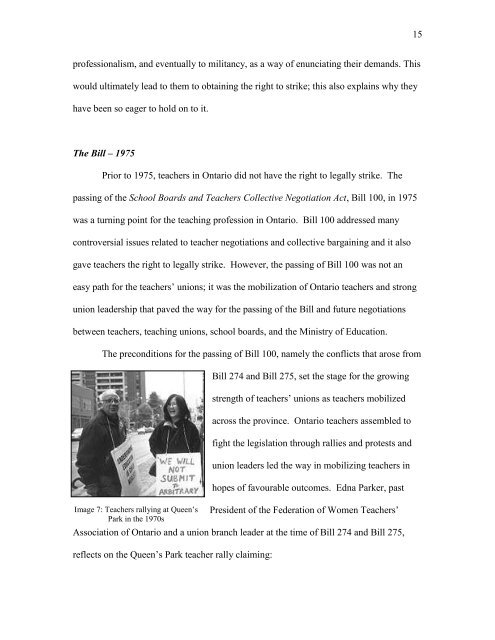THE HISTORY OF TEACHERS’ UNIONS IN ONTARIO
THE HISTORY OF TEACHERS’ UNIONS IN ONTARIO
THE HISTORY OF TEACHERS’ UNIONS IN ONTARIO
Create successful ePaper yourself
Turn your PDF publications into a flip-book with our unique Google optimized e-Paper software.
15professionalism, and eventually to militancy, as a way of enunciating their demands. Thiswould ultimately lead to them to obtaining the right to strike; this also explains why theyhave been so eager to hold on to it.The Bill – 1975Prior to 1975, teachers in Ontario did not have the right to legally strike. Thepassing of the School Boards and Teachers Collective Negotiation Act, Bill 100, in 1975was a turning point for the teaching profession in Ontario. Bill 100 addressed manycontroversial issues related to teacher negotiations and collective bargaining and it alsogave teachers the right to legally strike. However, the passing of Bill 100 was not aneasy path for the teachers’ unions;; it was the mobilization of Ontario teachers and strongunion leadership that paved the way for the passing of the Bill and future negotiationsbetween teachers, teaching unions, school boards, and the Ministry of Education.The preconditions for the passing of Bill 100, namely the conflicts that arose fromImage 7: Teachers rallying at Queen’sPark in the 1970sBill 274 and Bill 275, set the stage for the growingstrength of teachers’ unions as teachers mobilizedacross the province. Ontario teachers assembled tofight the legislation through rallies and protests andunion leaders led the way in mobilizing teachers inhopes of favourable outcomes. Edna Parker, pastPresident of the Federation of Women Teachers’Association of Ontario and a union branch leader at the time of Bill 274 and Bill 275,reflects on the Queen’s Park teacher rally claiming:












